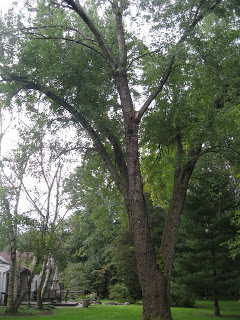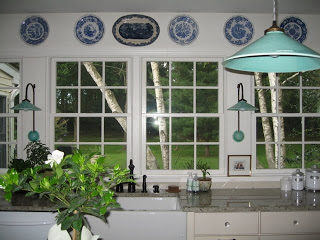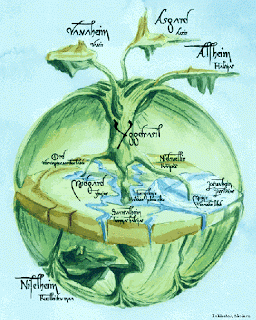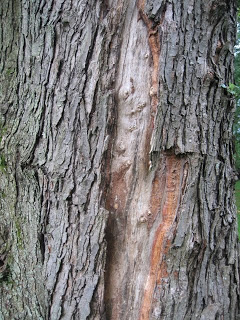Today the trees are coming down
God is the experience of looking at a tree and saying, “Ah!”- Joseph Campbell
This morning I woke early, made a cup of strong, fortifying coffee, and went outside to say goodbye to some friends. In about an hour a troop of men with chain saws will come and cut down seven old trees on my property, among them three I consider close friends: a lightning-struck silver maple (above) and two white birches.
I write looking out at trees. I consider them co-creators, friends, and teachers. I agree with Willa Cather, who said: “I like trees because they seem more resigned to the way they have to live than other things do.” (O Pioneers) and with William Cullen Bryant who, in A Forest Hymn, said, “The groves were God’s first temples.” When my spiritual director, the fabulous Sister Rita, asked me where I felt God’s presence, without hesitation I said, “In my garden, with the trees and birds.”
Every morning I wake up and head into the kitchen for the first cup of tea of the day. The birches, white against the green curtain of the garden, are the first things I see outside my kitchen window. In fact, they’re one of the reasons I fell in love with this house when I first saw it. I restructured the kitchen in order to have windows that focused on the birches and the big old maple beyond. When I saw them, when I fell in love with them, I forgot that all things come to an end, and that birches and maples, like people, will die. Some by old age, like the birches, some by violence, like the silver maple.
I love birches. Always have. The birch is the first tree of the Ogham, the Celtic tree alphabet, associated with purification, fertility and witches’ brooms. In an earlier time, bundles made of birch twigs were used to drive out the spirits of the old year. The birch tree is one of the first trees to come into leaf in the spring, and thus is often used as a symbol of new beginnings. As I did research for the book I’m presently writing, set in 7th century Anglo-Saxon Britain, I learned that the deities associated with birch are mostly love and fertility goddesses, such as the northern European Frigga and Freya. Eostre (from whom we derive the word Easter), the Anglo Saxon goddess of spring was celebrated around and through the birch tree between the spring equinox and Beltane.
(illustration by John Kahionhes Fadden)
“Then I was standing on the highest mountain of them all, and round about beneath me was the whole hoop of the world.And while I stood there I saw more than I can tell and I understood more than I saw; for I was seeing in a sacred manner the shapes of all things in the spirit, and the shape of all shapes as they must live together like one being. And I saw that the sacred hoop of my people was one of many hoops hat made one circle, wide as daylight and as starlight, and in the center grew one mighty flowering tree to shelter all the children of one mother and one father. And I saw that it was holy.” — Black Elk, 1931
In the Anglo-Saxon belief system the great tree of life is called Yggdrasil, the giant ash that links and shelters all the worlds. Beneath the three roots the realms of Asgard, Jotenheim, and Nifleim. . Three wells lie at its base: the Well of Wisdom; the Well of Fate (guarded by the Norns); and the Roaring Kettle, the source of many rivers. Four deer run across the branches of the tree and eat the buds; they represent the four winds. There are other inhabitants of the tree, such as the squirrel Ratatosk (“swift teeth”), a notorious gossip, and Vidofnir (“tree snake”), the golden cock that perches on the topmost bough. The roots are gnawed upon by Nidhogg and other serpents. On the day of Rganarok, the fire giant Surt will set the tree on fire.
The Ghillie Dhu is a solitary Scottish elf who lives in birches. His clothes are woven from leaves and moss. Like the Dryads who live in oak trees, I am told he will die with the tree. Oh dear.
A few weeks ago, on the full moon, I found myself wakeful at about 3:00 a.m. and so came downstairs so my tossing and turning wouldn’t disturb My Best Beloved. There were the birch trees, shining, glowing in the moonlight. I just stood there staring. They were like young girls, dressed in silver.
Ah, but they were not young anymore. They are old ladies, bald and
brittle. Every time a wind blows branches crash down on the roof and terrace. They are dying. And today the men will come. Tomorrow I’ll wake up and go to the kitchen and look out and they will be gone.
I wrote about the silver maple in another blog, talking about the night it was hit by lightning. We’ve spent a couple of years trying to save it, but this year huge hunks turned gray and dry and fell to the ground like cannonballs. It’s dangerous now. It’s fought a valiant fight, but it’s tired. And half of it’s gone. It’s time. I know. I burned some sweetgrass at the foot of the trees this morning, to send a prayer with with, and to thank them. I stood for a few moments with my hand on the great scar that pythons around the trunk of the old maple.
Do trees know, can trees sense? In the excellent book, “Tree” by my friend Wayne Grady and Dr. David Suzuki, it says this:
“Trees are communal, sometimes to the point of being communistic: they grow together in large groups, as though for comfort or protection. They have relationships — including sexual relationship through cross-pollination — and even communicate with other trees within their stands, including trees of their own kind as well as those of other species; they function for the benefit of the whole in sometimes startling ways; and they enter into mutualistic partnerships with other species — even other species so distantly related they belong to different orders — as surely as human being raise beans for food. ‘Far more than ourselves,’ writes John Fowls in THE TREE, ‘trees are social creatures and no more natural as isolated specimens than man is as a marooned sailor or hermit.’
And as I read on, I was astonished to learn this:
In an experiment conducted in 1979, three groups of willow trees were planted in pots and placed in sealed rooms, two groups in one room and the third group in another. Half of the trees in the first room were infected with leaf-eating caterpillars. After two weeks, the immune systems in the infected plants had been cranked up to repel the caterpillar invasion, and so were the immune systems in the uninfected trees in the same room; the trees in the isolated room, however were unaffected. Somehow the infested trees in the first room alerted the other trees in that room — and not my mycorrhizal communication, because the trees were in pots.
Mysterious. As so much of life is. And if I chose to believe that the trees know I celebrate them, and grieve their passing, perhaps that’s not so far fetched after all.
Ah… the sound of chainsaws. I can’t bear to watch. I’m going to take a walk in the woods.
Before I go… although the season is wrong, the sentiment is right. From Charlotte Mews, I’ll leave you with this.
The Trees are Down
—and he cried with a loud voice:
Hurt not the earth, neither the sea, nor the trees—
(Revelation)
They are cutting down the great plane-trees at the end of the gardens.For days there has been the grate of the saw, the swish of the branches as they fall,The crash of the trunks, the rustle of trodden leaves,With the ‘Whoops’ and the ‘Whoas,’ the loud common talk, the loud common laughs of the men, above it all.I remember one evening of a long past SpringTurning in at a gate, getting out of a cart, and finding a large dead rat in the mud of the drive.I remember thinking: alive or dead, a rat was a god-forsaken thing,But at least, in May, that even a rat should be alive.The week’s work here is as good as done. There is just one boughOn the roped bole, in the fine grey rain,Green and highAnd lonely against the sky.(Down now!—)And but for that,If an old dead ratDid once, for a moment, unmake the Spring, I might never have thought of him again.It is not for a moment the Spring is unmade to-day;These were great trees, it was in them from root to stem:When the men with the ‘Whoops’ and the ‘Whoas’ have carted the whole of the whispering loveliness awayHalf the Spring, for me, will have gone with them.It is going now, and my heart has been struck with the hearts of the planes;Half my life it has beat with these, in the sun, in the rains,In the March wind, the May breeze,In the great gales that came over to them across the roofs from the great seas.There was only a quiet rain when they were dying;They must have heard the sparrows flying,And the small creeping creatures in the earth where they were lying—But I, all day, I heard an angel crying:‘Hurt not the trees.’.





Lauren, I share your love of trees and feel your pain of loss. Your blog is a touching eulogy. Thank you.